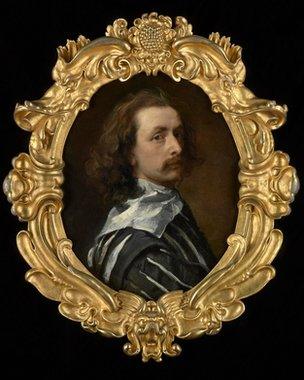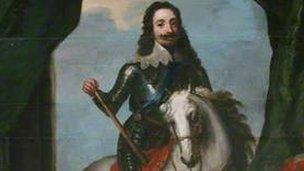Van Dyck appeal to keep self-portrait in UK
- Published

Van Dyck painted the self-portrait shortly before his death in 1641
Art lovers are being asked to raise £12.5m to keep the last self-portrait of Sir Anthony Van Dyck in the UK.
Painted by the Flemish artist shortly before he died, possibly of plague, in 1641, it has been described as "one of the finest and most important self-portraits" in British art.
Recently sold to a collector who wishes to take it abroad, it has become subject to a temporary export ban.
The National Portrait Gallery has three months to raise the cash to buy it.
It has already secured £1.2m, including a £500,000 grant from the Art Fund and £700,000 from its own budget.
The painting will go on display at the gallery while it tries to find the remaining £11.3m.

Van Dyck's paintings of Charles I made him a favourite in the court of the King
'Loud and dramatic'
"Van Dyck is one of the greatest artists to have worked in Britain," said National Portait Gallery director Sandy Nairne.
"No other artist has had such a dramatic impact on British portraiture. He decisively turned it away from the stiff, formal approach of Tudor and Jacobean painting, developing a distinctive fluid, painterly style that was to dominate portraiture well into the 20th century.
"It is very rare to have the opportunity to make a painting as important as Van Dyck's last self-portrait available to everyone in Britain."
Artist Julian Opie, whose portraits of pop band Blur hang in the National Portrait Gallery, said the work would be an important addition to the national collection.
"Although not large, this is a loud and dramatic painting," he said.
"You see Van Dyck as the artist, utterly confident and masterful with whipping brushstrokes of glistening paint. He is also the subject, witty, lively, a little cocky and very present.
"This is such a focused painting powerfully evoking a turbulent era. Nearly 400 years on and it sparkles with life and light."
Sir Anthony Van Dyck was born in Antwerp and became court artist for King Charles I in London in 1632.
The monarch gave him a knighthood, a golden chain and a £200 salary for his flattering portraits, which made the frail king seem imposing and powerful.
He painted only three self-portraits while in England, and it is the last of those that the National Portrait Gallery wishes to save.
Made only months before he died aged 42, it is housed in an elaborate, Italianate-English frame with a sunflower motif associated with the artist.
In 2009, it was sold for £8.3m at auction - nearly three times the estimate - breaking the previous auction record of £3.06m for his painting A Rearing Stallion.
It is believed to have been sold again in the interim.
If the campaign is successful, the gallery says the painting will be displayed both at its London home and at partner museums and galleries around the country.
Several works have recently been retained by the UK via similar fund-raising efforts.
Two 18th century George Stubbs paintings, featuring a kangaroo and a dingo, were obtained by the National Maritime Museum in Greenwich last month.
In September, the Jane Austen's House Museum in Hampshire raised £150,000 to keep a ring once owned by the author in the UK.
The gold and turquoise band, one of only three items of jewellery known to have belonged to Jane Austen, had previously been bought by US pop star Kelly Clarkson.